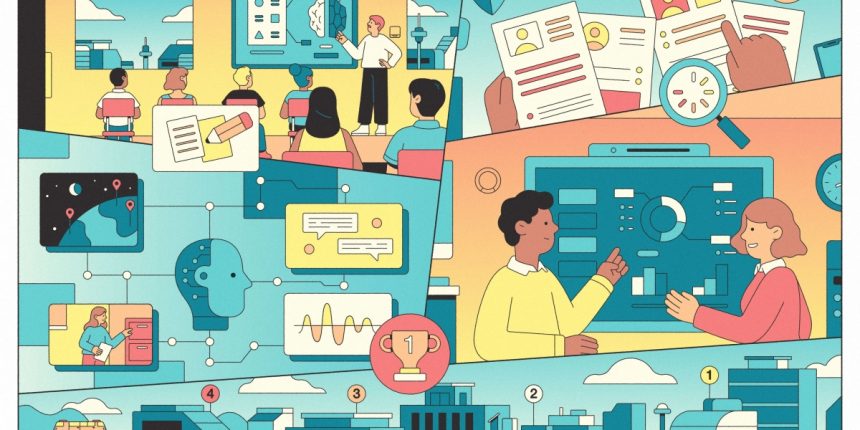In 2011, IBM put its Watson A.I. computing system, the size of a master bedroom, up against former Jeopardy! champions Ken Jennings and Brad Rutter—it won. In the final round of the three-day man-versus-machine match, Jennings offered a tongue-in-cheek concession: “I, for one, welcome our new computer overlords.”
That was more than a decade ago. Since then, OpenAI has reintroduced the world to A.I.’s potential with its November 2022 release of ChatGPT.
Though IBM is no longer at the forefront of A.I. development, as technology analyst Benedict Evans tells Fortune, the company is forcefully looking for ways to implement the technology into its operations. And to do that requires talent skilled in A.I.
In the 10 years since Watson wowed the masses, IBM has developed several A.I. tools designed to help businesses run more efficiently and accurately while maximizing productivity. But the problem this slate of A.I. offerings is meant to solve, IBM says, is a uniquely human one. Nickle LaMoreaux, the firm’s chief human resources officer, says that internally, A.I. has freed employees from back-office administrative work, allowing them to perform more nuanced work requiring human touch points.
It’s not an approach unique to IBM, but the company sees ample opportunity to leverage A.I. within its people operations and has invested heavily in it. One example is AskHR, a benefits virtual assistant of sorts. Rather than ask a manager or HR about vacation policy or dig through a maze of portals, employees can query Watson, which responds using data based on their tenure, location, and days already used.
IBM also uses A.I. during performance evaluation, automating the determination of which employees qualify for a raise or promotion. Its A.I. platform, LaMoreaux says, does the tedious work of culling through data, including past performance ratings, skills, whether employees are up to date on trainings, and their length of employment. It then sends recommendations to managers to cross-check. Managers can ask the A.I. why an employee isn’t on the list. The tool may respond, for instance, that the employee hasn’t met a certification requirement, and provide dates for upcoming certification exams.
With the time saved, LaMoreaux says, managers can invest in coaching employees on how they can improve and career progression.
“We’ve got over 280 different A.I. automations running inside HR right now,” LaMoreaux says. “That’s what is different here. It’s making HR more human because we’re spending time on things that matter.”
In an April op-ed for Fortune, IBM CEO Arvand Krishna argued that A.I. helps employers “tackle the kind of tasks most people find repetitive, which frees up employees to take on higher-value work.” He pointed to IBM, noting that its A.I. use has cut the number of HR professionals performing manual work from 700 to fewer than 50.
LaMoreaux says that, in total, IBM’s HR department has saved close to 12,000 hours in the last 18 months by automating systems that previously required back-and-forth exchanges between managers and employees.
The irony of IBM’s A.I. use case is that the same technology HR uses to expedite rote processes could ultimately put them out of work. In May, the company announced it would pause hiring for back-office roles—many in human resources performing duties like writing employment letters or overseeing cross-department employee transfers—A.I could perform. Bloomberg reported that the pause could impact roughly 7,800 jobs. LaMoreaux says the decision to freeze hiring for such roles was made intentionally and strategically.
“We don’t want to bring in a bunch of people and then find out that large portions of their job are actually being transformed by A.I.,” she says. “We are being cautious. We are pausing in certain jobs, so we can shift the hiring focus to the revenue-generating, product-building pieces.”
A.I.’s impact on the job market has long been a chief concern. The World Economic Forum said in a report last month that A.I. could affect around 40% of all working hours, with clerical and secretarial roles likely to see a quick decline.
U.S. companies cut more than 80,000 jobs last month, up 20% from April, according to a report from Challenger, Gray & Christmas. Nearly 4,000, or 5%, of those job cuts were A.I.-related. IBM, in January, announced it was cutting some 3,900 jobs, though management described those cuts as the result of selling off assets rather than signs of A.I.’s worker retrenchment.
But LaMoreaux admits she’s thinking ahead to what happens if IBM terminates employees due to A.I. “The thing companies need to think about is how [they] can provide skilling and programs well ahead of time,” she says. “If you’re at the point of severance, you’re already too late.” She urges companies to be transparent about their A.I. strategy and train employees on the tools and skills needed to remain integral to the company’s hereafter.
Pausing hiring for certain positions seems to LaMoreaux like a sensical first step as IBM continues its A.I. experimentation, gathers data on job efficacy, and upskills talent to meet the A.I. demands of the future.
“The real piece that we’ve got to get ahead of now is the 80% or 90% of jobs that aren’t going away, but that we all need to reskill on,” she says. “How can you provide skills and programs well ahead of time? Do you have a view 18 months from now? What portions of the job are going to change? Do people have access to training? That’s the pivot we need to make.”
IBM has for years championed skill–based hiring in tech, and LaMoreaux says that hasn’t changed as the company competes for top A.I. talent. More than 50% of IBM jobs in the U.S. don’t require a bachelor’s degree, she notes.
“We’re finding that individuals with some of these A.I. and automation skills have gotten them from nontraditional channels. Maybe they’ve taken community college classes or boot camps online. Some individuals have gained these skills in the military,” she says.
Across functions, LaMoreaux says, the company now assesses a host of new factors among job candidates: whether they can work alongside A.I. and large language models, ask the right questions, design an A.I. process for their domain, glean the right analysis, and understand what’s worth automating, to begin with. And if they’re short in some areas, they must be capable of continuous learning.
“It used to be that you could get a degree, become an expert in something, and it would carry you for an entire decades-long career. The half-life of skills is now shrinking because of new technology,” LaMoreaux says. “Whatever the next thing is, having the ability to continuously learn is the big differentiator for employees, regardless of what industry you’re going into, what job role you’re in, and if you’re early in your career or late in your career. This is going to be a defining skill.”
She adds: “Every company is a technology company right now. We’re all being impacted by A.I.”
Correction: A previous version of this story misnamed IBM’s AskHR A.I. tool. This story has been updated.
Read the full article here










